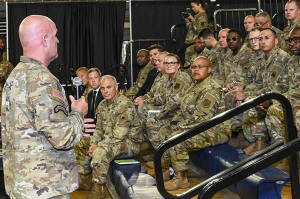Trump's takeover of Washington law enforcement begins as National Guard
troops arrive
[August 13, 2025]
By ASHRAF KHALIL and LINDSAY WHITEHURST
WASHINGTON (AP) — The new picture of law enforcement in the nation’s
capital began taking shape Tuesday as some of the 800 National Guard
members deployed by the Trump administration began arriving. The city’s
police and federal officials, projecting cooperation, took the first
steps in an uneasy partnership to reduce crime in what President Donald
Trump called — without substantiation — a lawless city.
The influx came the morning after the Republican president announced he
would be activating the guard members and taking over the District's
police department, something the law allows him to do temporarily. He
cited a crime emergency — but referred to the same crime that city
officials stress is already falling noticeably.
By evening, the administration was saying that National Guard members
were expected to be on the streets starting Tuesday night, according to
a White House official who was not authorized to speak publicly and
spoke on condition of anonymity. The Army said there were no specifics
on the locations they will be patrolling, according to an official who
spoke on condition of anonymity for the same reason.
Mayor Muriel Bowser pledged to work alongside the federal officials
Trump has tasked with overseeing the city's law enforcement, while
insisting the police chief remained in charge of the department and its
officers.
“How we got here or what we think about the circumstances — right now we
have more police, and we want to make sure we use them,” she told
reporters.

The tone was a shift from the day before, when Bowser said Trump's plan
to take over the Metropolitan Police Department and call in the National
Guard was not a productive step and argued his perceived state of
emergency simply doesn’t match the declining crime numbers. Still, the
law gives the federal government more sway over the capital city than in
U.S. states, and Bowser said her administration's ability to push back
is limited.
Attorney General Pam Bondi posted on social media that the meeting was
productive.
The law allows Trump to take over the D.C. police for up to 30 days,
though White House press secretary Karoline Leavitt suggested it could
last longer as authorities later “reevaluate and reassess." Extending
federal control past that time would require Congressional approval,
something likely tough to achieve in the face of Democratic resistance.
About 850 officers and agents fanned out across Washington on Monday and
arrested 23 people overnight, Leavitt said. The charges, she said,
included homicide, drunk driving, gun and drug crimes and subway fare
evasion. She didn't immediately provide further information on the
arrests.
The U.S. Park Police has also removed 70 homeless encampments over the
last five months, she said. People who were living in them can leave, go
to a homeless shelter or go into drug addiction treatment, Leavitt said.
Those who refuse could face fines or jail time.
The city and Trump have had a bumpy relationship
While Trump invokes his plan by saying that “we're going to take our
capital back,” Bowser and the MPD maintain that violent crime overall in
Washington has decreased to a 30-year low after a sharp rise in 2023.
Carjackings, for example, dropped about 50% in 2024 and are down again
this year. More than half of those arrested, however, are juveniles, and
the extent of those punishments is a point of contention for the Trump
administration.

Resident Jeraod Tyre, who's lived in Washington for 15 years, said he
does see crime slowing down. He's wary of the National Guard troops, who
don't have the same local knowledge as the city's regular police force.
"I feel safe walking through the city each and every day. The police are
doing a mighty fine job,” he said.
Bowser, a Democrat, spent much of Trump's first term in office openly
sparring with the Republican president. She fended off his initial plans
for a military parade through the streets and stood in public opposition
when he called in a multi-agency flood of federal law enforcement to
confront anti-police brutality protesters in summer 2020. She later had
the words “Black Lives Matter” painted in giant yellow letters on the
street about a block from the White House.
[to top of second column]
|

In this image provided by the U.S. Army National Guard, Vice Chief
of Staff of the Army Gen. James Mingus speaks with soldiers and
airmen from the District of Columbia National Guard at the D.C.
National Guard Armory in Washington, Tuesday, Aug. 12, 2025. (Sgt.
1st Class Christy L. Sherman/U.S. Army National Guard via AP)

In Trump's second term, backed by Republican control of both houses
of Congress, Bowser has walked a public tightrope for months,
emphasizing common ground with the Trump administration on issues
such as the successful effort to bring the NFL's Washington
Commanders back to the District of Columbia.
She watched with open concern for the city streets as Trump finally
got his military parade this summer. Her decision to dismantle Black
Lives Matter Plaza earlier this year served as a neat metaphor for
just how much the power dynamics between the two executives had
evolved.
Now that fraught relationship enters uncharted territory as Trump
has followed through on months of what many D.C. officials had
quietly hoped were empty threats. The new standoff has cast Bowser
in a sympathetic light, even among her longtime critics. “It's a
power play and we're an easy target,” said Clinique Chapman, CEO of
the D.C. Justice Lab and a frequent Bowser critic.
Where the power actually lies
Bowser contends that all the power resides with Trump and that local
officials can do little other than comply and make the best of it.
As long as Washington remains a federal enclave with limited
autonomy under the 1973 Home Rule Act, she said, it will remain
vulnerable to such takeovers.
Trump is the first president to use the law's Section 740 to take
over Washington’s police for up to 30 days during times of
emergencies.
For Trump, the effort to take over public safety in D.C. reflects an
escalation of his aggressive approach to law enforcement. The
District of Columbia’s status as a congressionally established
federal district gives him a unique opportunity to push his
tough-on-crime agenda, though he has not proposed solutions to the
root causes of homelessness or crime.

Trump's declaration of a state of emergency fits the general pattern
of his second term in office. He has declared states of emergency on
issues ranging from border protection to economic tariffs, enabling
him to essentially rule via executive order. In many cases, he has
moved forward while the courts sorted them out.
Bowser's claims about successfully driving down violent crime rates
received backing earlier this year from an unlikely source. Ed
Martin, Trump's original choice for U.S. attorney for the District
of Columbia, issued a press release in April hailing a 25% drop in
violent crime rates from the previous year.
Tom Power, resident of the hip Logan Circle neighborhood for over a
decade, said he occasionally hears about shootings or car break-ins,
but he's never been a victim himself. “I never felt threatened, I’ve
never given much thought to it,” he said.
Washington native Sheina Taylor said the troops are putting her on
edge. “It’s more fearful now because even though you’re a law
abiding citizen, here in D.C., you don’t know, especially because
I’m African-American," she said.
Trump's newly confirmed top federal prosecutor for Washington,
onetime judge and former Fox News host Jeanine Pirro, argued that
violent crime remains high and a significant issue for victims,
despite recent decreases. “These were vibrant human beings cut down
because of illegal guns,” she said.
___
Associated Press writers Alanna Durkin Richer in Washington,
Jonathan J. Cooper in Phoenix, Ali Swenson in New York and video
journalist River Zhang contributed reporting.
All contents © copyright 2025 Associated Press. All rights reserved
 |